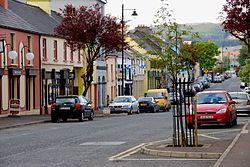Glenties
|
Glenties Na Gleannta
|
|
|---|---|
| Village | |

Glenties village, 2010.
|
|
| Location in Ireland | |
| Coordinates: 54°47′51″N 8°16′57″W / 54.7975°N 8.2825°WCoordinates: 54°47′51″N 8°16′57″W / 54.7975°N 8.2825°W | |
| Country | Ireland |
| Province | Ulster |
| County | County Donegal |
| Government | |
| • Dáil Éireann | Donegal South-West |
| • EU Parliament | North–West |
| Elevation | 78 m (256 ft) |
| Population (2011) | |
| • Urban | 869 |
| Time zone | WET (UTC+0) |
| • Summer (DST) | IST (WEST) (UTC-1) |
| Irish Grid Reference | G818944 |
Glenties (Irish: Na Gleannta, meaning "the glens") is a village in County Donegal, Ireland. It is situated where two glens meet, north-west of the Bluestack Mountains, near the confluence of two rivers. Glenties is the largest centre of population in the parish of Iniskeel. Glenties has won the Irish Tidy Towns Competition five times in 1958, 1959,1960, 1962 and 1995 and has won a medal many other times. The current population of Glenties is 869.
Evidence of early settlement in the area is given by the many dolmens, standing stones and earthen ringforts dating from the Bronze Age. The area became part of the baronies of Boylagh and Bannagh in 1609, which was granted to Scottish undertakers as part of the Ulster Plantation.
Glenties was a regular stopping point on the road between the established towns of Ballybofey and Killybegs, and grew from this in the 17th and 18th centuries. The town was developed as a summer home for the Marquess Conyngham in the 1820s, because of its good hunting and fishing areas. The court house and market house were built in 1843. The Bank of Ireland building was completed in 1880.
A workhouse was built during the Famine at the site of the current Comprehensive School in 1846, serving the greater Inniskeel area. A 40-bed Fever Hospital was later added to care for the sick and dying. The landlord, the Marquis of Conyngham, decided to halve the population of the town in 1847, faced by the rising costs of the workhouse. Only those who could show title to their land as rentpayers were allowed to remain. The rest were given an option of going to America on a ship provided or entering the Workhouse in Glenties. Over 40,000 people died or emigrated from Co. Donegal between the years 1841 and 1851.
...
Wikipedia

